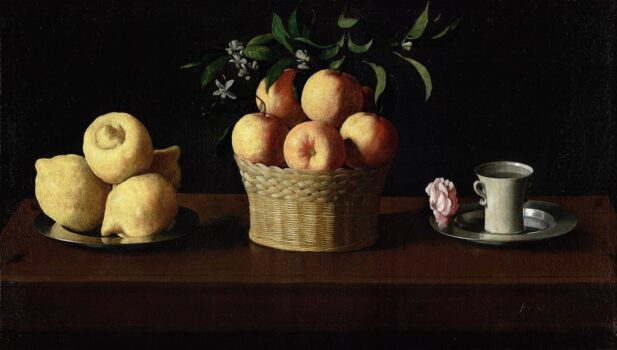The Meaning of Still Life with Lemons, Oranges and a Rose
Francisco Zurbaran, known for his luminous depictions of saints, monks, and biblical figures bathed in divine light, Zurbaran seemed to dwell in the intersection of austerity and transcendence. Yet, among his prolific body of work, one painting stands apart as a quiet but profound masterpiece: Still Life with Lemons, Oranges and a Rose (1633).
At first glance, it may appear deceptively simple. Three groups of objects are set against a stark black background: on the left, a plate of bright yellow lemons with a small white cup; in the middle, a basket of oranges accompanied by branches of leaves and blossoms; and on the right, a small dish with a single delicate pink rose and a cup of water. The objects are arranged with meticulous precision, each isolated yet somehow bound together through an invisible harmony.
This still life is more than just an exercise in naturalistic observation or a study in light and texture. It is a painting filled with symbolism, mystery, and spiritual resonance, reflecting the contemplative spirit of Zurbaran’s time and his deeply religious worldview. In this story-like exploration, we will journey through the historical context of the painting, the way Zurbaran crafted it, its possible meanings, and what it represents both artistically and spiritually.
Francisco de Zurbaran: The Painter of Silent Devotion
To understand this painting, one must first step into the world of its creator. Zurbaran (1598–1664) was born in Fuente de Cantos, in the Extremadura region of Spain. He trained in Seville, a thriving artistic hub in the early 17th century, where artists like Diego Velazquez and Alonso Cano were redefining Spanish art.
Zurbaran’s career was marked by commissions from monasteries and religious institutions. His style was ideally suited to the Counter-Reformation climate of Spain, where art was expected to encourage piety and devotion. His paintings are characterized by sharp contrasts of light and shadow (chiaroscuro), dramatic realism, and an austere clarity that mirrored the monastic ideals of simplicity and discipline.
While his reputation was built on religious paintings, particularly monumental altarpieces, Zurbaran occasionally turned to still life. Unlike the vibrant and lavish still lifes of Dutch painters, which were often filled with abundance and worldly pleasures, Zurbaran’s approach was strikingly austere. His still lifes are pared down, contemplative, and imbued with symbolic depth. Still Life with Lemons, Oranges and a Rose is his most famous and perhaps most enigmatic still life.
How Still Life with Lemons, Oranges and a Rose Was Painted
Created in 1633, the painting shows Zurbaran’s technical mastery and his ability to elevate ordinary objects into vessels of meaning. The composition is rigorously structured. Three groups of objects sit in a horizontal line across the canvas, each carefully balanced and illuminated by an unseen light source from the left.
On the left: a silver plate holds four ripe lemons. A small Chinese porcelain cup, filled with water, rests behind them.
In the center: a wicker basket contains several oranges, complete with their leaves and delicate blossoms, symbolizing freshness and life.
On the right: a shallow dish holds a single pink rose, accompanied by another porcelain cup filled with water.
Zurbaran used a pitch-black background, a hallmark of his style, to intensify the objects’ presence. This darkness is not merely a compositional device but a metaphorical space: a void in which light carves out truth and presence. The textures are rendered with almost photographic precision, the cool sheen of porcelain, the dimpled rind of the lemons, the woven pattern of the basket, the velvety softness of the rose petals.
The restraint in color is also striking. Yellow, orange, green, white, and soft pink are the main notes, arranged in harmony as though composing a silent chord of devotion. This disciplined palette reinforces the sense of solemnity and meditation.
Zurbaran painted it with oil on canvas, using thin, delicate layers to achieve luminosity. The objects are not cluttered but given breathing space, inviting the viewer to contemplate each one as though it were sacred. In this simplicity lies its transcendence.
What the Painting Is All About
At face value, the painting is a still life of fruits and flowers, everyday items that one might find on a monastic table in 17th-century Spain. But Zurbaran rarely painted without deeper purpose. The work resonates with themes of purity, devotion, and spiritual contemplation.
During the Counter-Reformation, art served as a bridge between the material and the spiritual. Zurbaran’s painting may be read as a meditation on the Virgin Mary, Christian virtues, and the fleeting beauty of earthly life. Its stillness is not empty but charged with symbolic meaning, like a silent prayer captured in pigment.
Symbolism and Meaning
Art historians have proposed several layers of symbolism in this work.
The Lemons
The lemons, with their sour taste yet vibrant appearance, can symbolize both the bitterness and vitality of life. In Christian iconography, citrus fruits sometimes represent purity and fidelity. Their bright yellow color could also symbolize the light of divine truth.The Oranges with Blossoms
The oranges, complete with leaves and blossoms, are often associated with purity and fruitfulness. In Seville, oranges were linked to the Virgin Mary, particularly her Immaculate Conception. The blossoms, representing renewal, suggest both chastity and spiritual blossoming.The Rose
The single rose is perhaps the most potent symbol. Roses are traditional emblems of the Virgin Mary (the “Mystical Rose”), as well as symbols of love and sacrifice. Its solitary presence, delicately placed in a dish, suggests a contemplative offering, a reminder of beauty’s fragility and spiritual transcendence.The Water in the Porcelain Cups
Water is a symbol of purity, baptism, and spiritual cleansing. The choice of porcelain, luxurious but simple, might emphasize both worldly refinement and spiritual clarity.The Triadic Structure
The arrangement of three groups across the canvas has been interpreted as an allusion to the Holy Trinity. Each group, lemons, oranges, and the rose, stands distinct yet harmonizes with the others, much like the Father, Son, and Holy Spirit.
In this sense, the painting is not a mere still life but a spiritual allegory, a visual meditation on faith and purity.
What Is Happening in the Painting?
Nothing moves in Still Life with Lemons, Oranges and a Rose. That is precisely the point. The painting captures a moment of absolute stillness, where time seems suspended. The objects rest in silence, yet they radiate presence, as if charged with divine light.
This stillness reflects the meditative practices of monastic life. For a monk contemplating this painting in a quiet cell, the fruits and flower would not just be objects of nature but symbols leading the mind toward prayer. The act of looking itself becomes a spiritual exercise, learning to see the eternal within the ordinary.
In a broader sense, what is “happening” here is not physical action but spiritual revelation. The painting invites the viewer to slow down, to look deeply, and to recognize the sacred hidden in the mundane.
Still Life with Lemons, Oranges and a Rose Type of Art
Zurbaran’s Still Life with Lemons, Oranges and a Rose belongs to the genre of bodegón, a Spanish form of still life painting that often depicted food, drink, or kitchenware arranged in austere compositions. Unlike Dutch still lifes, which often emphasized abundance, luxury, and vanitas themes, Spanish bodegones were usually simpler, more restrained, and infused with spiritual overtones.
This painting is a perfect example of how the bodegón could transcend mere representation. It is not only a study in naturalism but also a vehicle of contemplation. Its style is Baroque, marked by dramatic contrasts of light and shadow, yet it eschews theatricality for solemnity. One might even call it a mystical still life, a work where art and devotion merge seamlessly.
Where the Painting Is Today
Today, Still Life with Lemons, Oranges and a Rose resides in the Norton Simon Museum in Pasadena, California. It is considered one of the jewels of the museum’s collection, attracting art lovers, historians, and spiritual seekers alike.
Seeing the painting in person reveals qualities that reproductions cannot capture: the subtle glint of light on porcelain, the delicate veins of the rose petals, the palpable stillness of the black background. Standing before it, viewers often describe a sense of quiet awe, as though stepping into a sacred space.
The Enduring Significance
Why does this painting, created nearly four centuries ago, still resonate so deeply? Perhaps because it speaks to something timeless: the human longing to find meaning in simplicity, to glimpse the divine within the ordinary.
In a world of noise and distraction, Zurbaran’s still life offers silence. It invites us to slow down, to contemplate, and to recognize that even a lemon, an orange, or a rose can reveal truths about purity, sacrifice, and eternal beauty.
It also reflects the uniquely Spanish vision of art during the Golden Age: sober, devout, and charged with quiet intensity. In this sense, the painting is not only about fruits and flowers but about the Spanish spirit itself, resilient, austere, and deeply spiritual.
Francisco de Zurbaran’s Still Life with Lemons, Oranges and a Rose is far more than a still life. It is a silent symphony of objects, infused with meaning and mystery. Painted in 1633 with astonishing precision and simplicity, it reflects Zurbaran’s mastery of light, form, and symbolism.
The lemons, oranges, and rose are not just fruits and flowers; they are metaphors of purity, devotion, and divine presence. The porcelain cups of water, the triadic arrangement, and the stark black background all contribute to a composition that is both austere and transcendent.
What happens in the painting is nothing and everything: a suspension of time, an invitation to meditate, a glimpse of eternity in the everyday. As a bodegón, it belongs to the Spanish still life tradition, yet it transcends genre to become a spiritual icon.
Now housed in the Norton Simon Museum in Pasadena, this masterpiece continues to captivate viewers. Its quiet beauty and profound symbolism remind us that sometimes the simplest things, lemons, oranges, a rose, can carry the deepest meanings.
In the end, Zurbaran’s painting is about presence: the presence of objects, the presence of silence, and ultimately, the presence of the divine in the world around us.




